I miss my garden so hard right now, you guys. When the temps in Michigan start getting down to, oh, a million degrees below zero, everyone starts talking about taking warm-weather vacations: Florida, Texas, Cali. I’m not hating on those ideas, but I’m not interested. If I could have anything right now it would be just one evening here…
Glass mason jar of wine, chickens following me around, tomatoes straight from the vine. Yes, please.
But barring the invention of a time-travel machine or a magic wand, I’ve got a good four months until I’m back working in that little slice of heaven.
So, instead, I’ve been thinking a lot about what I’ll be doing differently in the garden this year. Because, honestly, despite getting the fence in and adding five new raised beds, and planting a ton of new things, last year was still kind of a bust as far as the actual harvest went.
First, the good things:
- The fence is up! Last year my garden was just five random beds in the middle of my yard, but now it’s a legit “space” on the farm.
- I put four new raised beds in this year, which meant shoveling a ton of dirt and gravel to fill the beds and walkways. (This was way easier to do with the tractor prior to having the fence in, by the way.)
- My mom bought me a bunch of berry bushes that we planted, and they survived the Summer at least.
- I managed to till up and plant the border beds with berries, herbs, and a lot of other awesomeness that should come back every year.
But nature also provided me with a lot of “teaching moments” this year too. Here are the major lessons I learned:
1.) Don’t start seeds too early – Last year I got super excited for spring and ended up starting a bunch of seeds indoors in late-march,which was not good. The plants got way too big indoors, and things were still frosting outdoors, and I had a constant low-grade sense of guilt/panic about planting everything. And then, of course, I planted things too early and at one point I found my mom at my house when I got home from work, building little makeshift tents around all the plants with, like, dishtowels, because she heard a frost was coming.
Seriously. Dishtowel tomato tents. That’s a real thing that happened.
So, this year I’m going to be smarter about when I start things indoor (late April) and when I plant them (early June) and I’m also going to remember to buy more dishtowels because you never know.
2.) Plant hybrids not heirlooms – I also jumped on the heirloom bandwagon last year big-time and ended up planting fourteen tomato plants (which is way too many) almost all of which were killed by some kind of blight. I had zero tomatoes “left over” to can, and barely enough to enjoy. There’s a reason hybridized plants were created, and its because they’re disease resistant and yield more with less work, so I’m going to go back to the types of plants I grew two years ago– Early Girl, Big Boy, Roma, and maybe just one or two heirloom varieties for fun.
They’re pretty, but that’s pretty much the full haul from 14 plants…
3.) Plant bush beans, and more of them – I’ve only ever planted green beans as bush beans, until last year when I (accidentally) started vine-style beans. The vines take a lot more management (and are harder to weed) and the beans all have the tough string that has to be removed, that I never had to worry with bush beans. I choked on that thing so many damn times last summer, I’m done with it.
On the other hand, my mom started some kidney beans for me last year, just a few plants, which were awesome and when harvested, gave me about a cup of dried beans. I’d love to have a ton of these to use in soups and other winter dishes, so I’m upping the number of bush beans (of all kinds) that I plant in spring.
4.) Plant the corn on time – Because I was trying desperately to remove all of the sod (and finish the fence, and a million other I’m-excited-it’s-not-snowing-anymore projects) I didn’t get the sweet corn in on time, and I didn’t get the glass gem corn in at all. Since I planted late, my corn only grew about three feet tall, and there were only a couple useable ears out of it.
So there were no corn salsas, or corn salads, or corn on the cob last year. And that was sad. But highly motivating for this year…
5.) More raised beds – Every time I post something on raised beds people ask me why raised beds instead of just planting things in the ground? Here’s why: weeds. I don’t know how other people manage their “row” crops, but even after cutting up and removing all of the sod, tilling, and mulching with straw between rows, I still ended up with 5′ tall weeds on that side of the garden. Yes. Taller than my corn plants. My raised beds, on the other hand, have great soil, great drainage, don’t get attacked by the local cottontail population nearly so much, and are so easy to weed.
Yes, it is a pain in the ass to build them, dig the holes to set them in the ground, fill them with dirt, and then shovel all the gravel for the walkways. But still… well worth it.
6.) Plant my favorite veggies – Somewhere in the whole “seed-starting/planting” debacle I missed out on growing some of my favorite veggies– there were no zucchini or brussels sprouts, or asparagus, or potatoes in my garden last year, so I’m determined to be more on top of things this year. And, luckily, I have a big list of the things I need to plant so that I don’t miss out on a great harvest this year…
I probably won’t get it all done, or all right, but I’m determined to make some major progress in the garden this year.
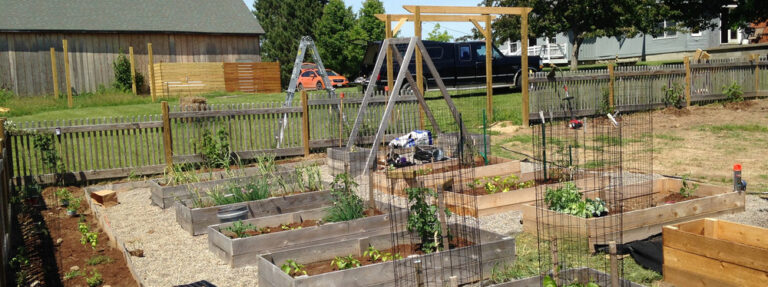


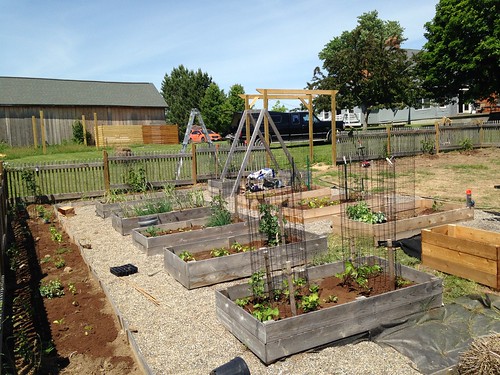

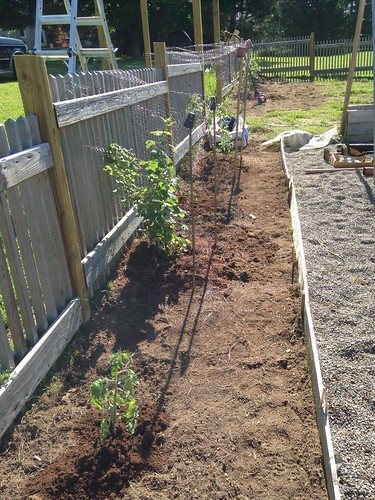
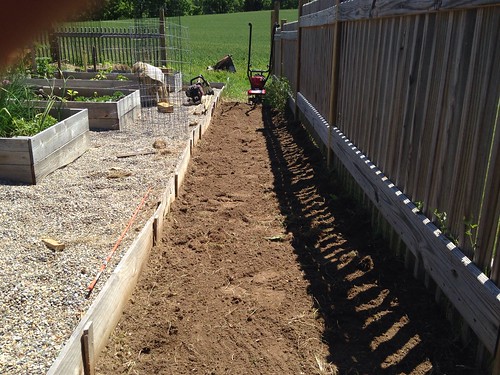
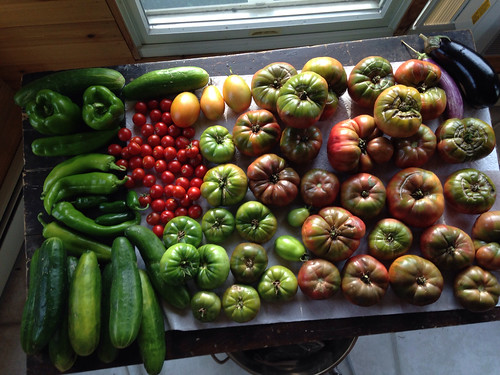

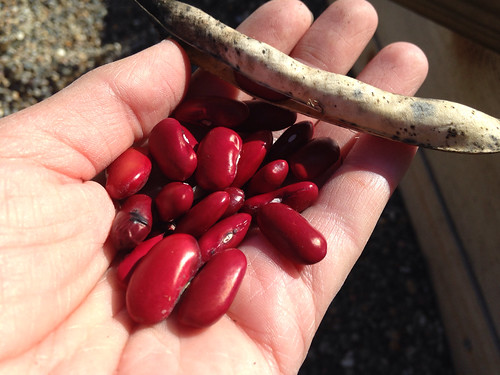
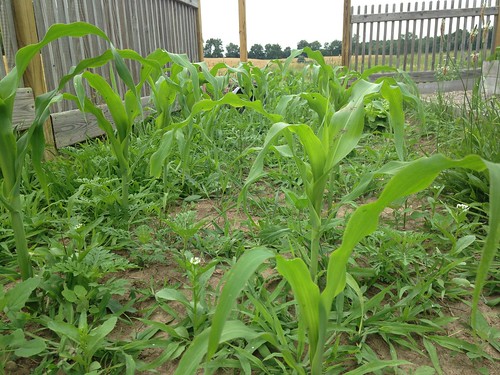
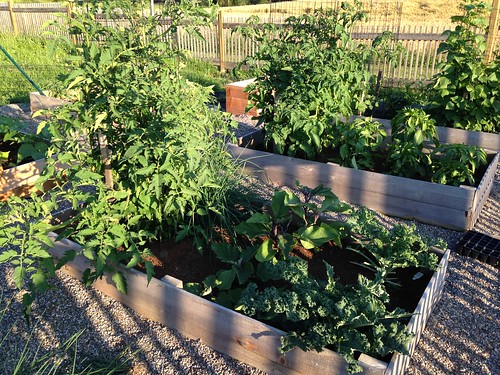
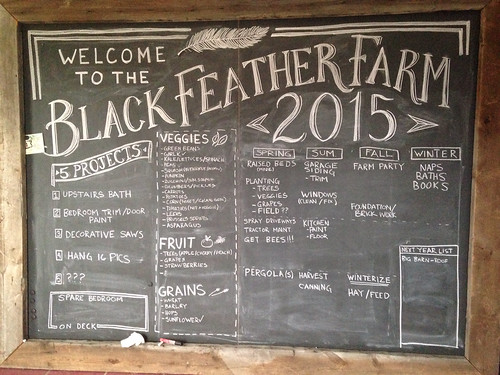
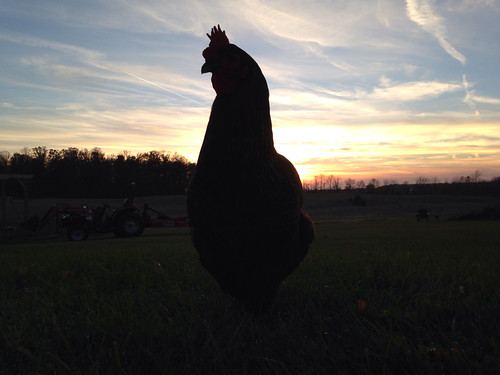

38 Responses
Love you blog. For the past several years I have planted my tomato plants outside, in the ground about a month earlier. For us, safe planting time is about April 15th. So about the middle to third week of March, I plant. I cage them and wrap the cages in clear plastic. After the fear of a hard frost is over, I will open just the top of the plastic. It can still frost a bit but won’t affect the plants. When all danger is past, I remove the plastic, usuall around the middle to third weekof April. This gives me bigger, stronger plants with a great yield. Might be something to try.
Ah, that sucks about the heirloom varietals.
We so far have had the best luck with the heirloom “Black Ethiopian.” Crazy fruitful and they reseeded themselves for the second year. We had so many plants we gave over a dozen to other neighbors and killed a few. Those fuckers are hardy (in California, anyway).
We’ve got our cauliflower, broccoli, kale, beets and brussels sprouts going right now. Didn’t end up doing potatoes this year. And still need to put the garlic in.
I HATE weeding. My favorite way to avoid weeding. After you plant put down a layer of newspaper and cover the paper with hay. Weeds can not push through. I once landscaped with some commercial LS fabric because I had stinging nettles I couldn’t control but the nettles grew anyway. Newspaper and hay, weed kryptonite. Then when you prepare your beds for the new planting till the old paper and hay into the soil. It all breaks down and improves the quality of the soil.
Awesome tip!
I think she means straw.
I’ve used both hay and straw. It just depends on what was easiest to get my hands in that year.
Ahem!!!
NAPS
BATHS
BOOKS
🙂
Kit,
We need to support companies who offer non-GMO, non-hybrid, open-pollinated, organic, and 100% untreated seeds. I know I am picky about this. Here’s why: EVERY PURCHASE MATTERS!
A good place to buy seeds is a company called SeedsNOW.com and there are many others.
Great post, honey, I just had to get my mini-rant in about what I believe in!
They have Heirloom/open-pollinated seeds, but I’m not exactly sure how they tackle that one!
For you and your mom, here’s a garden tip from your not-so-local greenhouse: Five gallon buckets. You can NEVER have enough of them. They make good seats while you weed, you can stick those weeds in them, make compost tea in them, you can collect water in them, you can haul your harvest in them (and pack rootstock for winter!), you can brine in them, and best of all (and most related to your post) you can use them as a super-fast tomato cover for frost protection. Invert a bucket over your tomato and boom. Tender babies protected.
I can’t wait until spring and garden planting time, too. Thank you for this post and reminding me the cold and gray will go away and soon we’ll have maters. (I love dish towel tents and now I want some!)
Gardening is a long term learning process. Sounds to me like your garden year was a success, because you learned.
I’m with your mom on non GMO seeds, and I hope you give heirlooms another try. And to make your life even more hectic, because we all know you don’t have enough on your plate, start saving seeds. If an heirloom works, save the seed, and the variety will adapt itself to your specific local climate and continue to flourish.
Enjoy the break, plan away, and get rested up–yeah, right–for a new season.
asparagus is awesome to grow, but it takes some time. new tubers need a couple years to grow before you can start harvesting. well worth it though once you get that first harvest.
I didn’t know that! But I’d like to have them in the ground, even if it takes a few years before they produce a good harvest. (More things I wish I would have done last year.)
Always learning through you and laughing along the way. Although your post was about what didn’t go right, it was super informative. It’s amazing what a garden teaches you from year to year. Last year was my first attempt at growing since we moved to the South from the West. BIG difference! Love your 2015 project board.
Try using 6-12 layers of newspaper under you mulch for the fence row crops. It helps to retain moisture, no weeding and you can just till it in the next spring. It decomposes and is good compost in place. I use it even in my raised beds to help retain moisture. Come fall I just cover it with the plants that are done that I pulled up and cover those with manure. Come spring, just till it all in. Compost in place, and the weeds don’t get a start in spring before I plant. Good luck.
Sorry to post again, but you might think about planting some marigolds in and around you garden. Marigolds are full of natural ammonia, the flowers, stems, roots and leaves all full of ammonia. Animals will leave your crops alone, they don’t like marigolds. But bees will still pollinate with the marigold there.
You never have to apologize about posting good ideas! Marigolds sound fun, maybe I’ll try it this year. (The fence does pretty good, but it was only half-done during the early part of last year, so that didn’t help.)
We use marigolds in our front flower beds so the wildlife doesn’t eat our flowers – it actually works wonderfully!
i told myself I’d plant all kinds of stuff this winter to get ready for the year but I still haven’t fixed the sprinklers! House projects never get done as fast or as cheap as you hope, huh?
Ha. Almost never!
Okay, first I love how you have plan for the year! I keep thinking that I am going to start a little binder of my plans for the next year’s garden, hopefully this is the year that I actually do it!
Second, I love your raised beds! I wish that we did ours that way. My in-laws do so much work in our garden and so there are many “cooks in the kitchen” and it will be so hard for me to convince the change. However, we make sure to plant all of our rows at least 4 feet apart that way we can run the tiller down the rows about once a week.
And finally, GLASS GEM CORN!?!? I can’t wait to see yours! I need to plant some myself!
Just found your site. Love it! Please give heirlooms another try. Seed Savers is a great place to get heirloom seeds. I use heirloom seeds exclusively now and don’t have any problems (love WI 55 and Boxcar Willy tomatoes). Last year was a crappy year for tomatoes in WI anyways, so maybe it was that way in MI too. And you should really rotate your tomatoes to a different spot if you had the blight last year.
Very interesting, looks like a beautiful farm you live on. It’s great to see some of the similarities in your work between your farm country and the work we do at the beach.
Hay!! Hay is FULL of weed seeds. Please use straw only. I have gardened organically for the last 34 years and I am a certified Master Gardener – use straw and well composted manure to reduce your weeding time.
Instead of buying extra dishtowels for frost protection, you could use cotton muslin purchased from almost any online fabric retailer, i.e. Joann’s, Hancock’s or Fabric.com. You can buy it by the yard or bolt and just rip it into the sizes you need. Not much for gardening but I have been reading your posts for the better part of 4 years just because you are a “Can Do” woman and I admire your resolve.
Can I just say (working for farmers and the ag community) AMEN to your comment about hybrids? Let’s try to understand why they were created to begin with (Blight, production, etc.) and not condemn all hybrids as evil. (I have this same issue with “organic” – research before you buy something with the label “organic” because “organic” is not always what you think it is). I got almost no tomatoes or peppers this year -I think I need to actually plant a garden rather than try to continue growing container veggies.
Hey Kit,
You can garden in the winter!
I was itching to get out to do some gardening. But Canada, in the winter. So I googled cold season gardening and found Eliot Coleman an organic farmer in Maine who farms all four seasons. He uses hoop houses to grow cold hardy vegetables like spinach and potatoes without heating. His book is called The Winter Harvest Handbook. You should check it out for your winter reading spree. It might just lead to a spring hoop house building spree!
Sara
While I do find reading about you rushing to get things done amusing, I would suggest maybe ordering your plantings so that you know which ones need a longer growing season, and plant those first, or start those inside. Also I think you complained about not having enough daylight hours with your job and other things to get everything in as soon as you liked last year, you might consider an extension cord and a flood light to work on into the evening, or just use your weekends to do it instead.
Strawberries are a perennial, though my family never had much luck with them. Rhubarb is also perennial, that grew better for us, and is great with the strawberries. Something being a perennial might change how you plan to plant it, just something to think about between now and spring. I know you have a lot of outdoor space and plants but some nice low maintenance house plants could brighten up your winter.
As for trees I think you can plant them in the fall too, if you don’t get to them as soon as you like. I would guess you can plant them in the summer as well, but they would need a lot more water then.
For now all I can do is live vicariously though your garden until I have a place of my own, though I have tired to be the crazy apartment plant lady. I’m sure you can never have too many plants or books.
I appreciate your thoughts on your raised beds. I’ve been trying to plan my garden and was thinking of reaching out to you to ask about the raised beds. I was planning on raised beds, but then I started to think that it would be easier to keep things flat so I can run the rototiller around. I love the look of raised beds, but tending them seemed very manual. Between Jennifer’s newspaper tip and your endorsement, I think raised beds are back on the list.
Good Morning Kit,
Writing from sunny Tsawwassen just south of Vancouver BC Canada.
Temperature today is around 6C. I am resisting working in the garden today as when it is soggy I do more damage than good.
However it is possible for me to turn my compost which I take every opportunity to do which helps it process more quickly.
Re raised beds. I have several raised beds (oh how I would love to have a garden the size that you have ) that were built up using the lasagna method.
This system has been around for an age but it makes such a difference to add all the organic matter to develop the soil. I have access to dry seaweed, autumn leaves, straw (not hay it may contain weeds), garden compost …. so in brief I am a compost fanatic!
I have asparagus, honeyberries, an ancient plum tree, espalier apples and pears.
I seed save seeds when relevent and grow sweet 100 tomatoes, early girl and roma. I was also very disappointed in heirloom varieties but I am trying to find one that suits by growing a different variety in a pot each year.
Green beans on frames, varieties of lettuce in a cold frame to bring them on early, kale etc. I do not have enough room to grow beans to dry but you have lots of room to do that.
Re marigolds, you want the French variety for pest control and to attract bees. Remember for bees and pollinating insects simple petal structure enables them to access pollen and nectar.
We now have a bee hive and my focus this year will be to begin to replace plants that are not as helpful to bees and also try and have flowers that have an extended blooming season.
Oh, well gardeners can go on and on – but I learn so much every year and it is always fascinating.
All the best – it is a wonderful time for research and planning – days are beginning to lengthen. Enjoy every one of them.
regards Janine
Re: marigolds
Aside from all of the previously noted practical reasons to plant marigolds, they continue to thrive and blossom long after summer ends. Orange-gold cheer right up until the bitter end.
There are a lot of plants that prevent weeds/blight/bugs that can be planted. Google “buddy planting” and you will find ALL the info. Basil and Lavender are good for planting near tomatoes. However, they are glorified weeds, so make sure you plant them in pots you stuck in the ground to contain their root structure.
Also, there are a lot of places that will sell praying mantises and REAL lady bugs (the little red kind, not the mutant orange japanese beetle kind) to “seed” your garden with in the spring. They will eat LOTS of things between them that aren’t your plants, with no sprays, etc. It takes a little work (like making little lady bug houses), but it sounds like you are moving into the bug husbandry business with the bees, so they might be fun to add to your list.
Hmmmmm – my weeds have no problem at all growing up through newspaper or plastic, and are just as happy growing in the hay which I have put down onto the newspaper.
I love my raised beds. Sure, I have a few weeds, but it does not compare to the ground garden beds!
And I toss my extra hay bales (by the flake) in with the chickens who thoughtfully remove all the seeds, and then I use THAT in the garden. The circle of liiiiiiiiife……..
Sorry, I’ve been behind on your posts, but I wanted to write in about a winter gardening technique that I’m trying for the first time. It’s called Winter Sowing, which is much like starting your seeds in a cold frame but doesn’t require building a permanent fixture outside. You reuse plastic containers (gallon milk jugs are excellent) as seed starting mini-greenhouses, leaving them outside to get covered with snow and plants naturally germinate as the temperature reaches the right conditions in their greenhouses and then harden off with fluctuating spring weather. You can start perennial seeds (especially ones that like cold stratification) as early as Christmas and start annuals and vegs in late March. This way you don’t have to tie up indoor space and provide constant lighting. There’s a forum on GardenWeb devoted to winter sowing and a lot of info at http://www.wintersown.org
My fingers are crossed that this technique will work for me, but many have had great success. I already had an oops with some poppy and shasta daisy containers that germinated in 6 days while they were inside my kitchen. My lazy ass was waiting for weather higher than 10 degrees so that I could shovel out a level area for the containers (I’m in MA).
I would suggest you forego some row planting and do a pilot of the square foot gardening method instead. Just dedicate some of your space to it, and compare it to rows. I think you’d love it. It’s way less weeding!
http://en.wikipedia.org/wiki/Square_foot_gardening
Good to see everything so systematic. And that details on learnt lessons, it can be one heck of a help for others. Learning from experience is a good thing. Great work, keep sharing.
I’m pretty much sure this might have been one of the best experience for you. Also, that’s some work. I mean everything so organized and planned. Good to see that.
Comments are closed.